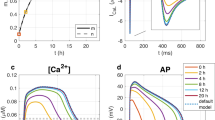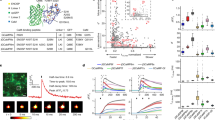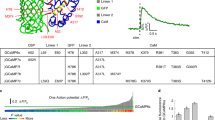Abstract
Calcium is central in the regulation of cardiac contractility, growth and gene expression. Variations in the amplitude, frequency and compartmentalization of calcium signals are decoded by calcium/calmodulin-dependent enzymes, ion channels and transcription factors. Understanding the circuitry for calcium signaling creates opportunities for pharmacological modification of cardiac function.
This is a preview of subscription content, access via your institution
Access options
Subscribe to this journal
Receive 12 print issues and online access
$209.00 per year
only $17.42 per issue
Buy this article
- Purchase on Springer Link
- Instant access to full article PDF
Prices may be subject to local taxes which are calculated during checkout



Similar content being viewed by others
References
Post, G.R., Hammond, H.K. & Insel, P.A. Beta-adrenergic receptors and receptor signaling in heart failure. Annu. Rev. Pharmacol. Toxicol. 39, 343–360 (1999).
Sugden, P.H. & Clerk, A. “Stress-responsive” mitogen-activated protein kinases (c-jun N-terminal kinases and p38 mitogen-activated protein kinases) in the myocardium. Circ. Res. 83, 345–352 (1998).
Cheng, H. et al. Excitation-contraction coupling in heart: new insight from Ca2+ sparks. Cell Calcium 20, 129–140 (1996).
Koss, K.L. & Kranias, E.G. Phospholamban: A prominent regulator of cardiac contractility. Circ. Res. 79, 1059–1063 (1996).
Gwathmey, J.K. et al. Abnormal intracellular calcium handling in myocardium from patients with end-stage heart failure. Circ. Res. 61, 70–76 (1987).
Mercadier, J.J. et al. Altered sarcoplasmic reticulum Ca2+ -ATPase gene expression in the human ventricle during end-stage heart failure. J. Clin. Invest. 85, 305–309 (1990).
Hasenfuss, G. et al. Relationship between Na+-Ca2+-exchanger protein levels and diastolic function of failing human myocardium. Circulation 99, 641–648 (1999).
Marx, S.O. et al. PKA phoshorylation dissociates FKBP12.6 from the calcium release channel (Ryanodine receptor): Defective regulation in failing hearts. Cell 101, 365–376 (2000).
Gao, W.D., Perez, N.G., Seidman, C.E., Seidman, J.G. & Marban, E. Altered cardiac excitation-contraction coupling in mutant mice with familial hypertrophic cardiomyopathy. J. Clin. Invest. 103, 661–666 (1999).
Bottinelli, R. et al. A mutant tropomyosin that causes hypertrophic cardiomyopathy is expressed in vivo and associated with an increased calcium sensitivity. Circ. Res. 82, 106–115 (1998).
Yanaga, F., Morimoto, S. & Ohtsuki, I. Ca2+ sensitization and potentiation of the maximum level of myofibrillar ATPase activity caused by mutations of troponin T found in familial hypertrophic cardiomyopathy. J. Biol. Chem. 274, 8806–8812 (1999).
Elliott, K., Watkins, H. & Redwood, C.S. Altered regulatory properties of human cardiac troponin I mutants that cause hypertrophic cardiomyopathy. J. Biol. Chem. 275, 22069–74 (2000).
Mukherjea, P., Tong, L., Seidman, J.G., Seidman, C.E. & Hitchcock-DeGregori, S.E. Altered regulatory function of two familial hypertrophic cardiomyopathy troponin T mutants. Biochemistry 38, 13296–13301 (1999).
Gao, W.D. et al. Role of troponin I proteolysis in the pathogenesis of stunned myocardium. Circ. Res. 80, 393–399 (1996).
Murphy, A.M. et al. Transgenic mouse model of stunned myocardium. Science 287, 488–491 (2000).
Chin, D. & Means, A.R. Calmodulin: a prototypical calcium sensor. Trends Cell Biol. 10, 322–328 (2000).
Dolmetsch, R.E., Xu, K. & Lewis, R.S. Calcium oscillations increase the efficiency and specificity of gene expression. Nature 392, 933–936 (1998).
Takeshima, H., Komazaki, S., Nishi, M., Iino, M. & Kangawa, K. Junctophilins: a novel family of junctional membrane complex proteins. Mol. Cell 6, 11–22 (2000).
Hardingham, G.E., Chawla, S., Johnson, C.M. & Bading, H. Distinct functions of nuclear and cytoplasmic calcium in the control of gene expression. Nature 385, 260–265 (1997).
Braun, A.P. & Schulman, H. The multifunctional calcium/calmodulin-dependent protein kinase: from form to function. Annu. Rev. Physiol. 57, 417–445 (1995).
Srinivasan, M., Edman, C.F. & Schulman, H. Alternative splicing introduces a nuclear localization signal that targets multifunctional CaM kinase to the nucleus. J. Cell. Biol. 126, 839–852 (1994).
Lisman, J. The CaM kinase II hypothesis for the storage of synaptic memory. Trends Neurosci. 17, 406–412 (1994).
Dolmetsch, R.E., Lewis, R.E., Goodnow, C.C. & Healy, J.I. Differential activation of transcription factors induced by Ca2+ response amplitude and duration. Nature 386, 855–858 (1997).
Timmermann, L.A., Clipstone, N.A., Ho, S.N., Northrop, J.P. & Crabtree, G.R. Rapid shuttling of NF-AT in discrimination of Ca2+ signals and immunosuppression. Nature 383, 837–840 (1996).
Noland, T.A. & Kuo, J.F. Phosphorylation of cardiac myosin light chain 2 by protein kinase C and myosin light chain kinase increases Ca2+-stimulated actomyosin MgATPase activity. Biochem. Biophys. Res. Commun. 193, 254–260 (1993).
Sweeney, H.L., Bowman, B.F. & Stull, J.T. Myosin light chain phosphorylation in vertebrate striated muscle: regulation and function. Am. J. Physiol. 264, C1085–C1095 (1993).
Witcher, D.R., Kovacs, R.J., Schulman, H., Cefali, D.C. & Jones, L.R. Unique phosphorylation site on the cardiac ryanodine receptor regulates calcium channel activity. J. Biol. Chem. 266, 11144–11152 (1991).
Xu, A. & Narayanan, N. Reversible inhibition of the calcium-pumping ATPase in native cardiac sarcoplasmic reticulum by a calmodulin-binding peptide. J. Biol. Chem. 275, 4407–4416 (2000).
Reddy, L.G., Jones, L.R., Pace, R.C. & Stokes, D.L. Purified, reconstituted cardiac Ca2+ ATPase is regulated by phospholamban but not by direct phosphorylation with Ca2+/calmodulin-dependent protein kinase. J. Biol. Chem. 271, 14964–14970 (1996).
Simmermann, H.K., Collins, J.H., Theibert, J.L., Wegener, A.D. & Jones, L.R. Sequence analysis of phospholamban: identification of phosphorylation sites and two major structural domains. J. Biol. Chem. 261, 13333–13341 (1986).
Dzhura, I., Wu, Y., Colbran, R.J., Balser, J.R. & Anderson, M.E. Calmodulin kinase determines calcium-dependent facilitation of L-type calcium channels. Nature Cell Biol. 2, 173–177 (2000).
Netticadan, T., Temsah, R.M., Kawabata, K. & Dhalla, N.S. Saroplasmic reticulum Ca2+/calmodulin-dependent kinase is altered in heart failure. Circ. Res. 86, 596–605 (2000).
Kirchhefer, U., Schmitz, W., Scholz, H. & Neumann, J. Activity of cAMP-dependent protein kinase and Ca2+/calmodulin-dependent protein kinase in failing and non-failing human hearts. Cardiovasc. Res. 42, 254–261 (1999).
Cameron, A.M. et al. Calcineurin associated with the inositol 1,4,5-trisphosphate receptor-FKBP12 complex modulates Ca2+ flux. Cell 83, 463–472 (1995).
Genazzani, A.A., Carafoli, E. & Geurini, D. Calcineurin controls inositol 1,4,5-trisphosphate type 1 receptor expression in neurons. Proc. Natl. Acad. Sci. USA 96, 5797–5801 (1999).
Moschella, M.C. & Marks, A.R. Inositol 1,4,5-trisphosphate receptor expression in cardiac myocytes. J. Cell Biol. 120, 1137–1146 (1993).
Hunter, J.J. & Chien, K.R. Signaling pathways for cardiac hypertrophy and failure. N. Engl. J. Med. 341, 1276–1283 (1999).
McKinsey, T.A. & Olson, E.N. Cardiac hypertrophy: sorting out the circuitry. Curr. Opin. Gen. & Dev. 9, 267–274 (1999).
Gruver, C.L., DeMayo, F., Goldstein, M.A. & Means, A.R. Targeted developmental overexpression of calmodulin induces proliferative and hypertrophic growth of cardiomyocytes in transgenic mice. Endocrinology 133, 376–388 (1993).
McDonough, P.M. & Glembotski, C.C. Induction of natriuretic factor and myosin light chain-2 gene expression in cultured ventricular myocytes by electrical stimulation. J. Biol. Chem. 267, 11665–11668 (1992).
Sato, Y. et al. Cardiac-specific overexpression of mouse cardiac calsequestrin is associated with depressed cardiovascular function and hypertrophy in transgenic mice. J. Biol. Chem. 273, 28470–28477 (1998).
Jones, L.R. et al. Regulation of Ca2+ signaling in transgenic mouse cardiac myocytes overexpressing calsequestrin. J. Clin. Invest. 101, 1385–1393 (1998).
Arber, S. et al. MLP-deficient mice exhibit a disruption of cardiac cytoarchitectural organization, dilated cardiomyopathy, and heart failure. Cell 88, 393–403 (1997).
Minamisawa, S. et al. Chronic phospholamban-sarcoplasmic reticulum calcium ATPase interaction is the critical calcium cycling defect in dilated cardiomyopathy. Cell 99, 313–322 (1999).
Miyamoto, M.I. et al. Adenoviral gene transfer of SERCA2a improves left-ventricular function in aortic-banded rats in transition to heart failure. Proc. Natl. Acad. Sci. 97, 793–798 (2000).
Morano, I., Bachle-Stolz, C., Katus, H.A. & Ruegg, J.C. Increased calcium sensitivity of chemically skinned human atria by myosin light chain kinase. FEBS Lett. 189, 221–224 (1985).
Sanbe, A. et al. Abnormal cardiac structure and function in mice expressing nonphosphorylatable regulatory myosin light chain 2. J Biol. Chem. 274, 21085–21094 (1999).
Aoki, H., Sadoshima, J. & Izumo, K.S. Myosin light chain kinase mediates sarcomere organization during cardiac hypertrophy in vitro. Nature Med. 6, 183–188 (2000).
Molkentin, J.D. et al. A calcineurin-dependent transcriptional pathway for cardiac hypertrophy. Cell 17, 215–228 (1998).
Zhu, W. et al. Ca2+/calmodulin-dependent kinase II and calcineurin play critical roles in endothelin-1-induced cardiomyocyte hypertrophy. J. Biol. Chem. 275, 15239–15245 (2000).
Rao, A., Luo, C. & Hogan, P.G. Transcription factors of the NFAT family: regulation and function. Annu. Rev. Immunol. 15, 707–747 (1997).
Black, B.L. & Olson, E.N. Transcriptional control of muscle development by myocyte enhancer factor-2 (MEF2) proteins. Annu. Rev. Cell. Dev. Biol. 14, 167–196 (1998).
Wu, H. et al. MEF2 responds to multiple calcium-regulated signals in the control of skeletal muscle fiber type. EMBO J. 19, 1963–1973 (2000).
Mao, Z. & Wiedmann, M. Calcineurin enhances MEF2 DNA binding activity in calcium-dependent survival of cerebellar granule neurons. J. Biol. Chem. 274, 31102–31107 (1999).
Blaeser, F., Ho, N., Prywes, R. & Chatila, T.A. Ca2+-dependent gene expression mediated by MEF2 transcription factors. J. Biol. Chem. 275, 197–209 (2000).
Olson, E.N. & Williams, R.S. Calcineurin signaling and muscle remodeling. Cell. 101, 689–692 (2000).
Sussman, M.A. et al. Prevention of cardiac hypertrophy in mice by calcineurin inhibition. Science 281, 1690–1693 (1998).
Shimoyama, M. et al. Calcineurin plays a critical role in pressure overload-induced cardiac hypertrophy. Circulation. 100, 2449–2454 (1999).
Hill, J.A. et al. Cardiac hypertrophy is not a required compensatory response to short-term pressure overload. Circulation 101, 2863–2869 (2000).
Zhang, W. et al. Failure of calcineurin inhibitors to prevent pressure-overload left ventricular hypertrophy in rats. Circ. Res. 84, 722–728 (1999).
Ding, B. et al. Pressure overload induces severe hypertrophy in mice treated with cyclosporin, an inhibitor of calcineurin. Circ. Res. 84, 729–734 (1999).
Lim, H.W. & Molkentin, J.D. Calcineurin and human heart failure. Nature Med. 5, 246–247 (1999).
Tsao, L., Neville, C., Musar, A., McCullagh, K.J. & Rosenthal, N. Revisiting calcineurin and human heart failure. Nature Med. 6, 2–3 (2000).
Janssen, P.M. et al. Influence of cyclosporine A on contractile function, calcium handling, and energetics in isolated human and rabbit myocardium. Cardiovasc. Res. 47, 99–107 (2000).
Irons, C.E., Sei, C.A., Hidaka, H. & Glembotski, C.C. Protein kinase C and calmodulin kinase are required for endothelin-stimulated atrial natriuretic factor secretion from primary atrial myocytes. J. Biol Chem. 267, 5211–5216 (1992).
Passier, R. et al. CaM kinase signaling induces cardiac hypertrophy and activates the MEF2 transcription factor in vivo. J. Clin. Invest. 105, 1395–1406 (2000).
Colomer, J.M. & Means, A.R. Chronic elevation of calmodulin in the ventricles of transgenic mice increases the autonomous activity of calmodulin-dependent protein kinase II, which regulates atrial natriuretic factor gene expression. Mol. Endocrinol. 14, 1125–1136 (2000).
Lu, J., McKinsey, T.A., Nicol, R.L. & Olson, E.N. Signal-dependent activation of the MEF2 transcription factor by dissociation from histone deacetylases. Proc. Natl. Acad. Sci. USA 97, 4070–4075 (2000).
Sparrow, D.B. et al. MEF-2 function is modified by a novel co-repressor, MITR. EMBO J. 18, 5085–5098 (1999).
Kuo, M.H. & Allis, C.D. Roles of histone acetyltransferases and deacetylases in gene regulation. Bioessays 20, 615–626 (1998).
McKinsey, T.A., Zhang, C.L., Lu, J. & Olson, E.N. Regulation of skeletal muscle differentiation by signal-dependent nuclear export of a histone deacetylase. Nature (in the press).
Youn, H.D., Grozinger, C.M. & Liu, J.O. Calcium regulates transcriptional repression of myocyte enhancer factor 2 by histone deacetylase 4. J. Biol. Chem. 275, 22563–22567 (2000).
Han, J., Jiang, Y., Li, Z., Kravchenko, V.V. & Ulevitch, R.J. Activation of the transcription factor MEF2C by the MAP kinase p38 in inflammation. Nature 386, 296–299 (1997).
Kolodziejczyk, S.M. et al. MEF2 is upregulated during cardiac hypertrophy and is required for normal post-natal growth of the myocardium. Curr. Biol. 9, 1203–1206 (1999).
Taigen, T., De Windt, L.J., Lim, H.W. & Mokentin, J.D. Targeted inhibition of calcineurin prevents agonist-induced cardiomyocyte hypertrophy. Proc. Natl. Acad. Sci. 97, 1196–1201 (2000).
Rothermel, B. et al. A protein encoded within the Down syndrome critical region is enriched in striated muscles and inhibits calcineurin signaling. J. Biol. Chem. 275, 8719–8725 (2000).
Bristow, M.R. et al. Decreased catecholamine sensitivity and beta-adrenergic receptor density in failing human hearts. N. Engl. J. Med. 307, 205–211 (1982).
Dorn, G.W. 2nd, Tepe, N.M., Lorenz, J.N., Koch, W.J. & Ligett, S.B. Low- and high-level transgenic expression of beta-adrenergic receptors differentially affect cardiac hypertrophy and function in Galphaq-overexpressing mice. Proc. Natl. Acad. Sci. USA 96, 6400–6405 (1999).
Rockman, H.A. et al. 1998. Expression of a beta-adrenergic receptor kinase 1 inhibitor prevents the development of myocardial failure in gene-targeted mice. Proc. Natl. Acad. Sci. USA 95, 7000–7005 (1998).
Acknowledgements
We thank A. Tizenor for assistance with graphics and J. Page for editorial assistance. Work in the authors' laboratory was supported by grants from National Institutes of Health, the D.W. Reynolds Foundation, the Robert A. Welch Foundation and Myogen Inc. N.F. was supported by a postdoctoral fellowship from Deutsche Forschungsgemeinschaft and T.A.M. is a Pfizer Fellow of the Life Sciences Research Foundation.
Author information
Authors and Affiliations
Corresponding author
Rights and permissions
About this article
Cite this article
Frey, N., McKinsey, T. & Olson, E. Decoding calcium signals involved in cardiac growth and function. Nat Med 6, 1221–1227 (2000). https://doi.org/10.1038/81321
Issue Date:
DOI: https://doi.org/10.1038/81321
This article is cited by
-
The function of LncRNA-H19 in cardiac hypertrophy
Cell & Bioscience (2021)
-
Histone deacetylase (HDAC) 9: versatile biological functions and emerging roles in human cancer
Cellular Oncology (2021)
-
MYH7B variants cause hypertrophic cardiomyopathy by activating the CaMK-signaling pathway
Science China Life Sciences (2020)
-
Cardiac Pacemaker Cells Generate Cardiomyocytes from Fibroblasts in Long-Term Cultures
Scientific Reports (2019)
-
Kdm6A Protects Against Hypoxia-Induced Cardiomyocyte Apoptosis via H3K27me3 Demethylation of Ncx Gene
Journal of Cardiovascular Translational Research (2019)



